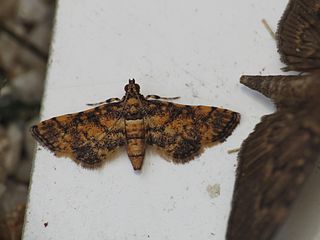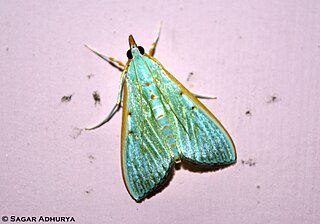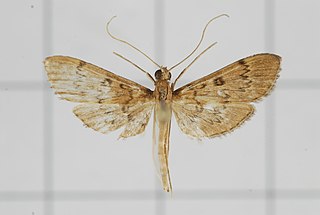
Glyphodes negatalis, the karanj defoliator, is a moth of the family Crambidae. The species was first described by Francis Walker in 1859. It has a wide range in the tropics, including South Africa, The Gambia, Mali, India, Sri Lanka, Hong Kong, Japan and eastern Australia.

Hypolamprus is a genus of moths of the family Thyrididae described by George Hampson in 1893.

Metasia tiasalis is a species of moth of the family Crambidae.

Banisia myrsusalis, the sapodilla borer or sapota midrib folder, is a species of moth of the family Thyrididae. It was described by Francis Walker in 1859 and is found in North America, Brazil, Australia, southern Asia and Africa.

Agrioglypta eurytusalis is a moth in the family Crambidae described by Francis Walker in 1859. It is found in southern India, Sri Lanka, Borneo, Cambodia, Thailand, Taiwan, Japan and Australia, where it has been recorded from northern Queensland.

Arthroschista hilaralis, also known as the kadam defoliator, is a moth in the family Crambidae. It was described by Francis Walker in 1859. It is found in India, Sri Lanka, Burma, Cambodia, Sumatra, Borneo and in Australia, where it has been recorded from Queensland.

Glyphodes canthusalis is a moth in the family Crambidae. It was described by Francis Walker in 1859. It is found in Taiwan, mainland India, Sri Lanka and on the Andaman Islands, Vietnam, Indonesia and Australia.

Pycnarmon meritalis is a moth in the family Crambidae. It was described by Francis Walker in 1859. It is found in Democratic Republic of the Congo, South Africa, Australia, China, Sri Lanka, India, Indonesia, Taiwan and Japan.

Rehimena phrynealis is a moth in the family Crambidae. It was described by Francis Walker in 1859. It is found in China, Thailand, Sri Lanka, Papua New Guinea, Borneo, the Philippines, Korea, Taiwan, Fiji and Australia, where it has been recorded from the Northern Territory and Queensland.

Tatobotys janapalis is a moth in the family Crambidae. It was described by Francis Walker in 1859. It is found in Japan, Taiwan, Sri Lanka, India, Myanmar, Borneo, Indonesia the Solomon Islands. It is also found in Australia, where it has been recorded from Queensland and New South Wales.
Brana is a monotypic moth genus of the family Noctuidae. Its only species, Brana calopasa, is found in Sri Lanka and Australia. Both the genus and species were described by Francis Walker, the genus in 1858 and the species in 1859. It It is a serious pest on Berrya cordifolia.
Avitta ophiusalis is a moth of the family Noctuidae first described by Francis Walker in 1859. It is found in Indian subregion, Sri Lanka, China, Japan, Sundaland, Sulawesi, Queensland, Solomon Islands, Vanuatu, Fiji and New Caledonia.
Hadennia mysalis is a moth of the family Noctuidae first described by Francis Walker in 1859. It is found in Sri Lanka, Japan, Taiwan, Thailand, Borneo, Myanmar and the Andaman Islands.

Hydrillodes gravatalis is a moth of the family Erebidae first described by Francis Walker in 1859. It is found in the Indian subregion, Sri Lanka and Sundaland.
Dichromia indicatalis is a moth of the family Erebidae first described by Francis Walker in 1859. It has a large distribution area of Indo-Australian tropics to Japan and Solomon Islands.
Hypena mandatalis, is a moth of the family Erebidae first described by Francis Walker in 1859. It is found in the Indian subregion, Pakistan, Sri Lanka, Borneo, Sulawesi and Australia.
Mathoris loceusalis is a moth of the family Thyrididae first described by Francis Walker in 1859. It is found in India, Sri Lanka and Australia.
Hypolamprus angulalis is a moth of the family Thyrididae first described by Frederic Moore in 1888. It is found in Malaysia, Myanmar and Sri Lanka.
Hypolamprus striatalis is a moth of the family Thyrididae first described by Charles Swinhoe in 1886. It is found in Sri Lanka. and India.
Hypolamprus subrosealis is a moth of the family Thyrididae first described by John Henry Leech in 1889. It is found in Sri Lanka.










